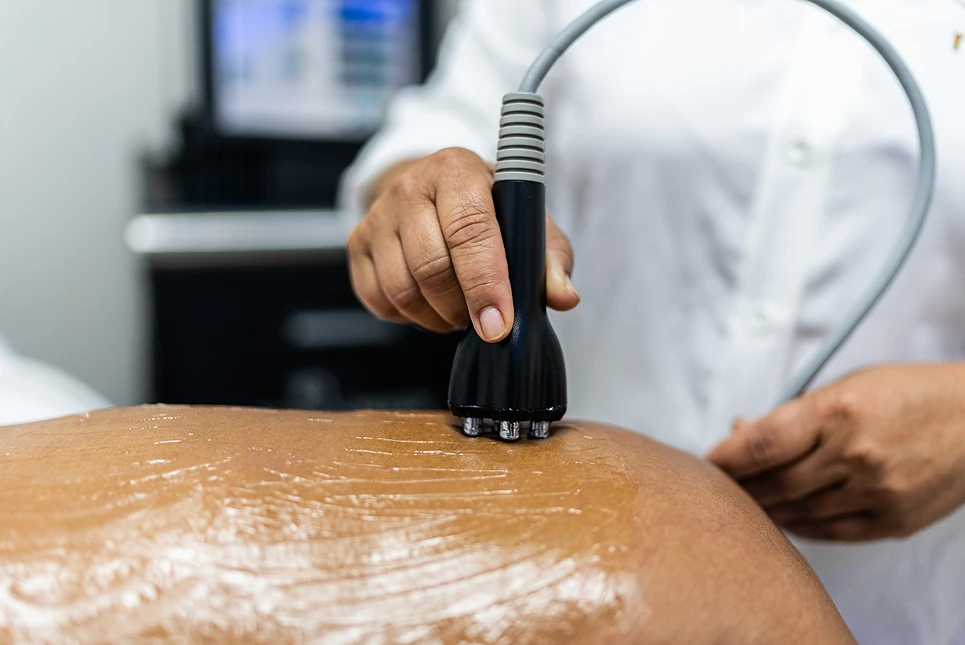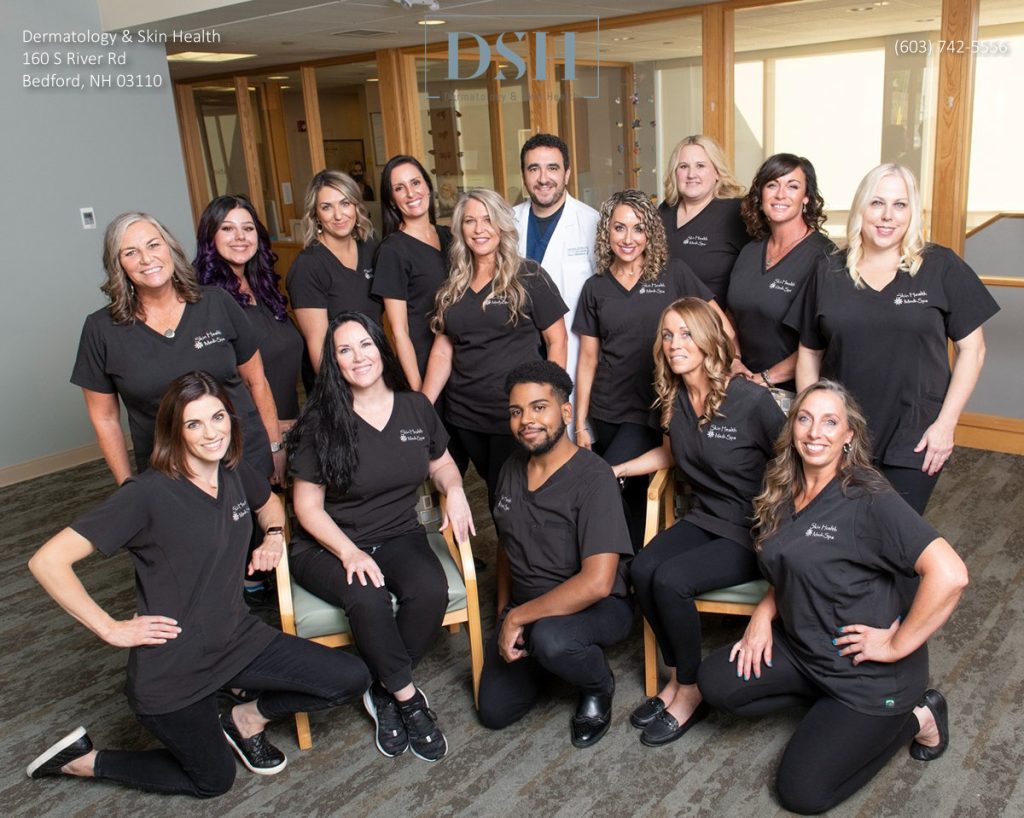


Dermabrasion after Mohs surgery can improve the look of scars by smoothing the skin's surface. This procedure gently sands away the top layers of skin to help scars appear less noticeable.
Skin cancer is the most common cancer in the United States, with over 5 million cases treated each year. Basal cell carcinoma and squamous cell carcinoma, the two most common types of skin cancer, are typically treated surgically.
One common and effective technique is Mohs surgery, which involves removing thin layers of skin and examining them under a microscope until no cancer cells remain.
While Mohs surgery has a high cure rate for skin cancer, it can sometimes leave behind surgical defects or scars with an uneven texture and appearance. This is especially true when the cancer occurs on highly visible areas like the face and nose.
Dermabrasion can be performed after Mohs surgery to refine the skin’s surface and minimize scarring.
Schedule a consultation with our dermatologists to see if dermabrasion can refine your skin's texture and minimize scarring after Mohs surgery
Dermabrasion involves removing the outer layers of the skin through controlled abrasion. It is defined as a surgical procedure that uses a rotating wheel or brush to smooth the skin's surface by removing the outer layers of skin.
A handheld device with a rotating wheel or brush covered in diamond particles, crystal particles, or a wire brush is used to gently “sand” the skin’s surface. This process allows for damaged or scarred skin to be smoothed out by removing the topmost skin layers where irregularities exist.
There are several methods and devices used to perform dermabrasion. Some of the more popular ones include:
There are key differences between crystal and diamond microdermabrasion:
| Feature | Crystal Microdermabrasion | Diamond Microdermabrasion |
| Abrasion Method | Stream of fine aluminum oxide crystals propelled onto the skin | Diamond-tipped wand rubbed on the skin |
| Intensity | More aggressive exfoliation | More gentle exfoliation |
| Depth of Exfoliation | Deeper into skin layers | Shallower exfoliation |
| Suitable Skin Types | Thicker, oilier, less sensitive skin | Sensitive skin, rosacea, eczema |
| Redness/Irritation | Higher risk of redness and irritation | Lower risk of redness and irritation |
| Pain Level | Can be more painful | Typically less painful |
| Equipment Cost | Lower | Higher |
| Post-Treatment Care | More downtime, recovery | Minimal downtime |
| Results | Removes more dead skin cells | Gentler improvement of skin texture |
| Sessions Needed | Fewer sessions for desired results | May require more sessions |
No matter the technique, the principle remains the same - superficial skin layers are removed to improve texture and appearance.

Dermabrasion is commonly used after Mohs surgery on cosmetically sensitive areas like the face, neck, nose or hands. During the Mohs procedure, layers of skin cancer are methodically removed until the margins are clear. This process can leave behind surgical defects with uneven borders or subtle differences in contour, especially around the nose.
Dermabrasion performed on the nose after Mohs surgery helps blend and smooth out any irregularities or edges from the excision. It minimizes visible scarring and helps achieve a more uniform nasal contour after surgery.
Other benefits of dermabrasion after Mohs surgery include:
Dermabrasion enhances the cosmetic results of Mohs surgery by minimizing residual imperfections for better scar appearance.
Discuss how you can improve the appearance of surgical scars on sensitive areas after Mohs surgery by booking a visit with our expert - Dr. Gary Mendese
Ideal candidates for dermabrasion after Mohs surgery include those with light-colored skin, limited sun damage, and shallow surgical defects. Those with darker complexions are at higher risk for discoloration or hyperpigmentation after dermabrasion. The procedure may not be suitable for surgical sites that are larger, deeper, or highly concave.
It’s also important to have reasonable expectations. Mild scars can often be significantly improved, but the deepest scars may only show modest improvement. Discussing candidacy with your dermatologist is important to determine if dermabrasion is right for you.
Potential side effects during the healing process include:
With proper aftercare, these typically resolve within 1-2 weeks. There is a small risk of infection, which can be minimized with proper wound care and antibiotics if needed.
Those with active acne, a history of keloid scars, or certain skin conditions like rosacea may not be good candidates. Detailed medical history and skin evaluation will help determine appropriateness and risks. Your dermatologist can advise you on this based on the specifics of your case.
Dermabrasion is performed as an outpatient procedure under local anesthesia. The treatment area is thoroughly cleansed and mapped out. A topical numbing agent is applied for around 30 minutes before the procedure begins. The typical process follows the steps below:
The procedure steps are performed in a meticulous and incremental manner for optimal results. The dermatologist's skill and experience are critical in controlling the intensity and depth of abrasion.

After the procedure, there will be varying degrees of redness, swelling, oozing and crusting which may last for 1-2 weeks. Most patients are able to resume regular activities within 3 to 7 days.
Proper aftercare is crucial for healing. This includes:
Use a mild, fragrance-free cleanser and lukewarm water to gently cleanse the area twice daily. Avoid harsh scrubbing. Pat dry with a soft towel.
Apply a thin layer of petroleum jelly or an antibiotic ointment like polysporin to keep the wound moist. This helps prevent scab formation and promotes healing. Reapply 1-2 times per day.
It's crucial to avoid sun exposure on the healing skin for at least 3 months post-procedure. Apply SPF 30 or higher sunscreen to the area daily. Wear wide-brimmed hats and protective clothing outside.
Follow your doctor's instructions for taking over-the-counter pain relievers like acetaminophen or ibuprofen to manage discomfort. Prescription medication may be given for more significant pain.
Look out for increased redness, swelling, oozing, foul odor or fever as these can indicate infection. Contact your dermatologist immediately if any of these occur.
Studies show vitamin E supplements can minimize scarring. Take 400-800 IU daily while healing. Check with Dr. Mendese first to see what dose of vitamin E is right for you.
For at least 1-2 weeks, avoid exercise, yardwork, lifting and any activity that could disturb the wound. Walking and other light activities are okay.
Keeping your head elevated, especially when sleeping, can help minimize swelling during the first few days.
See your dermatologist as scheduled for wound checks and suture removal. Follow all at-home care instructions closely for proper healing.
With appropriate aftercare, most patients heal well with minimal scarring and improved cosmetic outcomes. However, poor wound care can increase risks of scarring and infection. Be diligent with the wound care regimen for best results.
Get instructions on proper dermabrasion aftercare from the Dermatology and Skin Health team designed to optimize healing after Mohs surgery
While dermabrasion remains a top option for scar revision after Mohs surgery, alternatives may include:
| Treatment | Description |
| Laser Skin Resurfacing | Fractional ablative or non-ablative lasers can improve scar texture with less downtime in recovery. Lasers work well for deeper scars. |
| Steroid Injections | Injections of steroids like triamcinolone or kenalog may improve scar appearance for certain individuals by flattening and softening the scar tissue. |
| Topical Silicone Gels/Sheets | Silicone products worn on the skin have subtle smoothing effects on scars and help hydrate the tissue. Better suited for smaller, mild scars. |
| Dermal Fillers | Subdermal injections of hyaluronic acid fillers can raise depressed scars to the level of surrounding skin. Provides a smoothing effect. |
Dr. Gary Mendese can advise you on whether lasers, injections, silicone products or fillers would be preferable alternatives based on your specific case and scar characteristics.
The cost of dermabrasion can range widely depending on the provider, facility fees and extent of treatment. Average costs are typically:
In general, cosmetic applications of dermabrasion are not covered by insurance. However, dermabrasion after reconstructive Mohs surgery may be covered, especially if performed within 6-12 months after cancer excision.
Check with your insurance provider as coverage can vary significantly. Out-of-pocket payment plans or financing options are available through many dermatology practices to assist with any costs that insurance does not cover.

Dermabrasion is a proven technique that can enhance outcomes after Mohs surgery. By smoothing scars and blending the surgical site, dermabrasion helps patients restore their skin’s appearance. For those seeking to minimize scarring and improve texture after skin cancer treatment, dermabrasion may be the solution.
Patients interested in Mohs surgery are encouraged to schedule a consultation with Dr. Gary Mendese and the team of skin health experts at Dermatology and Skin Health. With multiple locations in southern New Hampshire and northern Massachusetts, our dermatologists can advise whether dermabrasion is suitable for your specific case.
Schedule your appointment today to discuss your skin’s needs with compassionate professionals dedicated to helping you look and feel your best!
If your desired appointment type or preferred provider is unavailable online, kindly call (978) 525-0100 for Peabody, MA and (603) 742-5556 for all New Hampshire locations. Alternatively please feel free to send us your request via the patient portal, or via email at info@dermskinhealth.com
*For medical dermatology appointments in MA please dial (978) 525-0100 or fill out the appointment request form above.